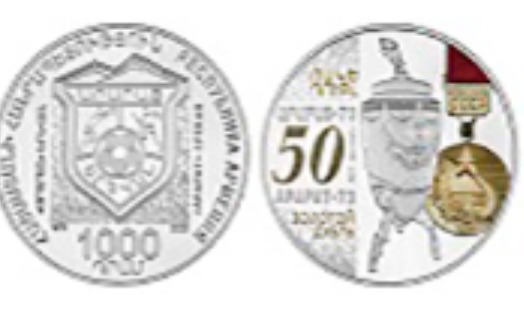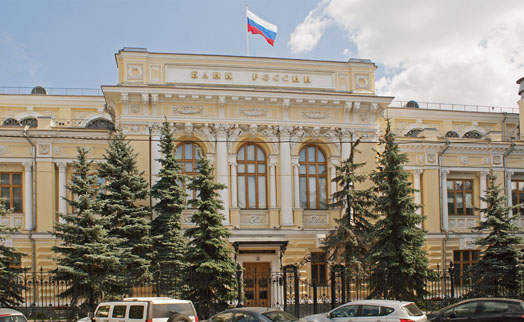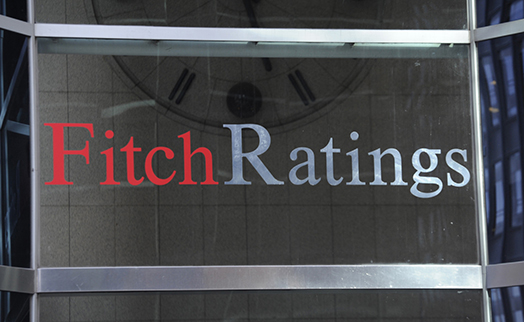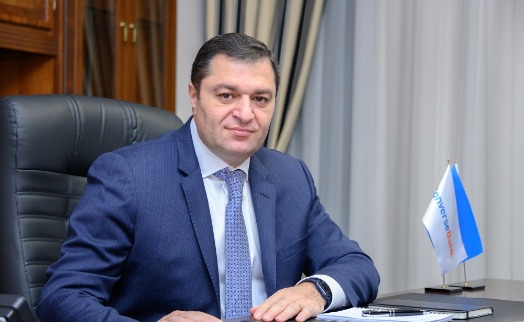20.06.2023 14:08

YEREVAN, June 20, /ARKA/. Armenia's Central Bank has put today into circulation three collector coins- “100th Anniversary of Foundation of Armenian Cinema”, “100th Anniversary of Hagop Hagopian’s Birth” and “Ararat-73 – 50th Anniversary of Golden Double” silver collector coins into circulation.
The collector coin dedicated to the 100th anniversary of foundation of Armenian cinema.
There were individual Armenians who, since the 1910s, had attempted to shoot Armenian films in different countries of the world. On April 16, 1923, the government of Soviet Armenia founded the Petkino (State Cinema), later renamed as “Haykino”, “Hayfilm” (“Armenkino”, “Armenfilm”). This is how the history of Armenian cinematography began. In 1926, Hamo Beknazaryan, the founder of homegrown cinema, made the first silent feature film, “Namus”, and in 1935, the first Armenian sound film, “Pepo”. In 1938, by the film “The Dog and the Cat”, Lev Atamanov founded the Armenian animated cinema; in 1954, the first Armenian color film “The Secret of the Mountain Lake” was shot.
The film production really started off in the 1950-60s as many memorable films were shot, including “The Song of the First Love” (directors: Yuri Yerznkyan and Laert Vagharshyan), “What’s All the Noise of the River about” (director: Grigor Melik-Avagyan), “Tzhvzhik” (director: Arman Manaryan), “The Boys of the Orchestra” (directors: Henrik Malyan and Henrik Margaryan), etc, in which Hrachya Nersisyan, Avet Avetisyan, Vagharsh Vagharshyan, Khoren Abrahamyan, Varduhi Varderesyan, Metaqsya Simonyan, Mher Mkrtchyan, Sos Sargsyan, Armen Dzhigarkhanyan and other actors shone with all their mastery.
In Cannes in 1965, Henrik Margaryan's film “The Priest’s Promise” was included for the first time in the short film program of the festival, and “Hello, It’s Me” by Frunze Dovlatyan was included in competition section in 1966.
There were many feature, animated and documentary films shot in the 1970-80s. Sergei Parajanov (“The Color of Pomegranates”), who was considered a cinema innovator with his unique worldview, and Artavazd Peleshyan (with his epic films using virtuoso editing and addressing national and universal themes), came to international fame and stood out in the world cinematography with a unique style. Robert Sahakyants' films were widely recognized in the animation genre.
In 1985, Albert Mkrtchyan’s film “The Tango of Our Childhood” was presented at the Venice International Film Festival, and the film’s leading actress Galya Novents won a special jury award.
During the independence period since 1990s, the Armenian cinema continued with some ups and downs. Private studios opened up and production volumes increased. By decision N 1110 as of July 20, 2006 of the Government of the Republic of Armenia "Hayfilm" film studio named after H. Beknazaryan was renamed to the “National Cinema Center of Armenia”, which is an organization implementing state cultural policy in the field of cinematography. The National Cinema Center of Armenia has largely contributed to production, promotion and development of the Armenian cinematography, and the newly emerged generation of directors endevours to expand the creative horizons of Armenian cinema while looking to hold best traditions.
The 100-year history of Armenian cinematography has created more than 700 feature films, about 2500 documentary, factual documentary and nearly 300 animated films.
Obverse: the logotypes of “Haykino” and “Hayfilm” studios.
Reverse: the stylized images of a film strip and а projector.
Designers: Lusine Lalayan (obverse), Eduard Kurghinyan (reverse).
The coin is minted at the Mint of Poland.
Technical specification
Face value 1000 dram
Metal/fineness silver 9250
Weight 33,6 g
Diameter 40,0 mm
Quality proof
Edge ribbed
Quantity of issue 200 pcs
Year of issue 2023
Collector coin dedicated to the 100th anniversary of Hagop Hagopian’s birth
Hagop Hagopian (1923-2013) is a painter, sculptor, People's Artist of the Armenian SSR (1977), a correspondent member of Academy of Fine Arts of the USSR (1988), an active member of Academy of Fine Arts of the Russian Federation (1996).
Hagopian was born in Alexandria (Egypt); studied at the Melqonian College in Cyprus (1934-1941), the Cairo Academy of Fine Arts (1944-1947) and the Academie de la Grande Chaumiere in Paris (1952-1954).
Hagopian's early works are primarily still lifes and thematic paintings, which emphasize the feeling of sadness and loneliness (“Woman in the Kitchen” (1959), “Garlic” (1961), “Sorrow” (1961), “Tailor” (1962), “Man and Plant” (1963), etc.
In 1962, Hagopian settled in Armenia where he developed his art to embrace new vital nuances.
He depicted Armenia the way he perceived it - with colors appearing not vividly but clear and restrained, harmonious and balanced. A love so infinite for Mother Nature gave birth to “Spring” (1969), “Serenity” (1971), “Beside the Canal” (1972), “Sevan Shore” (1991) and other paintings.
Along with paintings, the intense imagination of the artist helped creating unique sculptures by putting different parts of various metallic tools together. One of the metallic sculptures called “Family” (1989) stands on the slope of Mount Aragats. Hagopian’s intended monument – the blessing hand of Gregory the Illuminator – embellishes the road to Etchmiadzin.
The geography of Hagopian’s solo exhibitions is widespread: Yerevan, Gyumri, Vanadzor, Tallinn, Tartu, Riga, Vilnius, Odessa, Lviv, Kiev, Tbilisi, Rostov-on-Don, Stavropol, Novorossiysk, Moscow, St. Petersburg, Paris, Nicosia, Helsinki, Beirut, Pasadena, and elsewhere.
The rewards, Hagop Hagopian earned, include the state awards of the Armenian SSR (1977) and of the USSR (1985), the “Hayastan” All-Armenian Fund Award (1994), the Order of St. Mesrop Mashtots (1996), the Order of St. Sahak-St. Mesrop of the Armenian Apostolic Church (2003), the Honorary Citizen of Yerevan (2001), the Award of the President of the Republic of Armenia (2013, posthumous).
The National Gallery of Armenia boasts a significant part of the great artist’s creative heritage.
Obverse: Hagop Hagopian’s “Man and Plant” painting (1963).
Reverse: Hagop Hagopian in his studio.
Designer: Haroutiun Samuelian.
The coin is minted at the Mint of Poland.
Technical specifications
Face value 100 dram
Metal/fineness silver 9250
Weight 28,28 g
Size 28,0 x 40,0 mm
Quality BU
Edge even
Quantity of issue 250 pcs
Year of issue 2023
Collector coin dedicated to the 50th anniversary of the golden double of “Ararat” football team
The “Ararat” football team of Yerevan was created in 1935 (in 1935-1937 and 1954-1962 the team was called “Spartak”, in 1937-1954 – “Dynamo”, and starting 1963 – “Ararat”). The team participated in a great number of All-Union and international football matches.
1973 was stellar for “Ararat”. It was when the team led by the coach Nikita Simonyan won both the USSR Cup and the title of the USSR Champion.
On October 10, 1973 “Ararat” defeated Dynamo Kiev 2:1 in the final game of the USSR Football Cup in Moscow and won the Cup. It was Levon Ishtoyan, the forward of the team, who scored the two winning goals.
Days after the victory, there was another match between “Ararat” and “Zenith” of Leningrad taking place at the stadium “Hrazdan” in Yerevan, where thanks to the spectacular goals of Hovhannes Zanazanyan, the captain of “Ararat”, and Eduard Margarov “Ararat” won the game 3:2 and took the title of the USSR Champion, thus making a golden double.
The double achievement of “Ararat” called as “Armenian football boom” became one of the bright pages of the Soviet sports. The leading team of Armenia rose atop the pedestal of honor due to excellent physical training of the players, sportsmanship, technical mastery, high morale, strong will and team spirit.
Even today - 50 years later - the excitement of the glorious victory of “Ararat-73” has not faded in the memories of Armenian football fans.
In 2013 twelve veterans of “Ararat-73” were awarded the 1st degree medal “For Services to the Homeland” for their significant contribution to the development of Armenian football and brilliant sport achievements.
A monument immortalizing the victories of “Ararat-73” (sculptor: V. Hambardzumyan, 2013) is installed in Agarak village of Aragatsotn region; a statuary to the players and coaches of the team embellishes the place adjacent to the stadium “Hrazdan” in Yerevan (author: T. Barseghyan; head of the sculptors’ group: A. Samvelyan, 2016).
Obverse: the “Ararat” football team emblem (1973).
Reverse: the USSR Cup, Medal of the USSR Top League Champion (1973).
Designer: Vardan Vardanyan.
The coin is minted at the Mint of Poland.
Technical spesification
Face value 1000 dram
Metal/fineness silver 9250
Weight 33.6 g
Diameter 40.0 mm
Quality proof
Edge ribbed
Quantity of issue 400 pcs
Year of issue 2023
Notice:
Collector coins are made of precious metals and are issued to present to the society the national, international, historical and cultural, spiritual and other values of the country, to immortalize these values in the metal and to meet the demands of the numismatic market.
Like any other currency the collector coins have face value which makes them the means of payment. However, the face value of these coins is much lower that their cost price which includes the cost of the precious metal used for manufacturing of the coin, mintage and other expenses. Low face value and high cost price allow these coins to be considered as the items of collection and not the means of payment used in money circulation. The collector coins have also the sale price set by the Central Bank of Armenia.
As the items of collection the collector coins are issued in very restricted quantities and are not reissued.
Numismatists, collectors and all interested persons can buy the Armenian collector coins in the sales salon “Numismatist?” which is in the building of the Central Bank of Armenia and is open for everyone. -0-
Read the news first and discuss them in our Telegram
Tags:






















